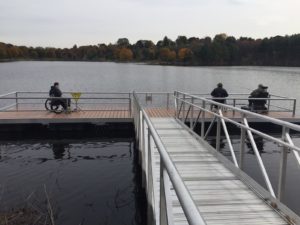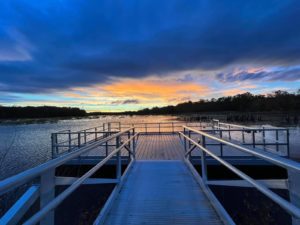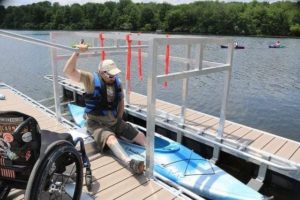
BoardSafe Docks, an industry leader in the design, engineering, and manufacturing of aluminum-welded floating docks, is often asked about our dock-building process. BoardSafe Docks prides itself on educating our valued customers and supporting them through the manufacturing process.


We have listed 10 considerations for prospective buyers to be aware of during the design, engineering, and manufacturing phase of their projects.
If you’ve decided to work with BoardSafe Docks for our industry expertise, you’ve made the right choice. Working with a dock builder you trust will strengthen your professional relationship and translate into a more pleasant building experience.
Following are some key points to learn and understand about the design, engineering, and manufacturing process.
Choose an experienced floating dock builder.
Customers prefer to select a dock builder with prior dock-building experience. Ask how long the dock builder has been doing this type of work. Visit completed dock projects to see what they look like after the installation, as well as jobs they completed five years earlier so you have an idea of their strength, durability, and performance over time. Speak with and review references from prior customers. Since no two waterfronts are ever the same, neither will be floating dock projects. Projects will always vary; therefore, successful prior experience will ensure you’re getting a quality product that lasts. Take the time to research completed projects and reviews before you hire your contractor. Your dock is more than a regular construction project, so don’t waste time with inexperienced or novice builders.
Communicate with your designer-dock builder.
A trusted dock designer will be one you can easily contact and communicate with. Do they respond to your phone calls and emails in a timely manner? Establish in advance your preferred method of communication and the frequency of communication and how payments will be made. Map out a schedule for updates regarding the progress of your project. Dock projects can take time to complete—from designing, engineering, and ordering materials, through fabrication.
Structural integrity of the dock design and materials
You can’t have a quality dock without quality materials! That means asking your floating dock designer about the best type of dock for your environment, its features, and their recommended materials. The kind of dock, its location, and the materials used, will tell you a lot about the quality of their product. If the designer tends to use a certain product or material, you can look up information about the company and decide if you think it’s a good fit. Purchasing a floating dock is a big investment that you want to last for many years to come.
The durability of an aluminum floating dock
Be sure to ask how your dock will stand up against various weather elements. Understand what type of maintenance will be required during the winter months, during changes in tidal conditions, and when there’s flooding or drought. This will reveal the considerations your designer needs to make for your dock regarding the local weather and demands of the waterway. Customers who experience any type of extreme weather, traffic, or tidal conditions, should ensure their designer prepares for it.
Project timeline for the floating dock
When it’s time to really get serious about your project, one of the critical questions you must ask is about your designer’s timeline. Try to zero in on a specific schedule and have some aspect of timeline expectations in your contract.
Site preparation prior to installation
Well before construction even begins, make sure your designer has the plan to protect and prepare your property for the dock’s installation. If trucks and other equipment must be driven through your yard, make sure you know how you want your dock builder to access your property from both land and water. Understand what site work may need to be completed prior to the installation of your floating dock system and who is responsible for that site work. Make sure it is completed prior to the arrival of your dock.
Permits for your water access project
Find out what regulations govern your property prior to starting any waterfront access project. Start with your town building code department and work your way up. Also check for the county, state, and federal regulations that might affect your property. Know who is responsible for obtaining your permits—your landscape architect, the engineer, the dock builder, or the property owner.
Unexpected change orders
There are always unintended changes that may arise during the construction of your project. Ask your designer what the process will be if changes to the design are necessary—especially if they will result in changes in cost. Make it clear that you want to know about changes and any additional costs in advance if necessary.
Consider the end goal early in your floating dock project.
It’s important to consider the entirety of your floating dock project at the start of your project. If you have questions, ask them. If you have your eye set on additional dock accessories, communicate that in advance. Customers who change their design ideas in the middle of the project need to expect additional costs and additional time for completion. These little steps can make a big impact on the timing of construction and your overall satisfaction with your completed boat dock.
Understand the warranty of your floating dock system.
Asking these questions will set you up for an extremely successful relationship with your dock designer. You’re much less likely to face setbacks and disappointments if you set up a good foundation of understanding from the beginning.


When you find a professional dock builder, ask if they provide annual maintenance packages for your floating dock system, especially if you live in an area where docks need to be removed for the winter months. If they do, it’s a good idea to establish a recurring maintenance schedule.
BoardSafe Docks understands the benefits and impact their floating dock systems offer to communities and park systems. Their inclusive launch is fitted for kayaks, canoes, and SUPS, and gets everyone in the water safely and easily. We know paddlers want close-to-home recreation; safe, easy, and inclusive access to the water; and the ability to connect their families to nature and their local community. BoardSafe’s fishing piers allow their users to enjoy the outdoors safely away from active boat launches and access points. Our floating dock systems for marinas enhance the ability to safely secure vessels in the water, allowing boaters to come onto land for dining and other recreational activities.
To discuss your project and create a water entry site that offers safe and easy access with inclusive and adaptive features, contact us at 610-899-0286 or through our website at BoardSafeDocks.com.
